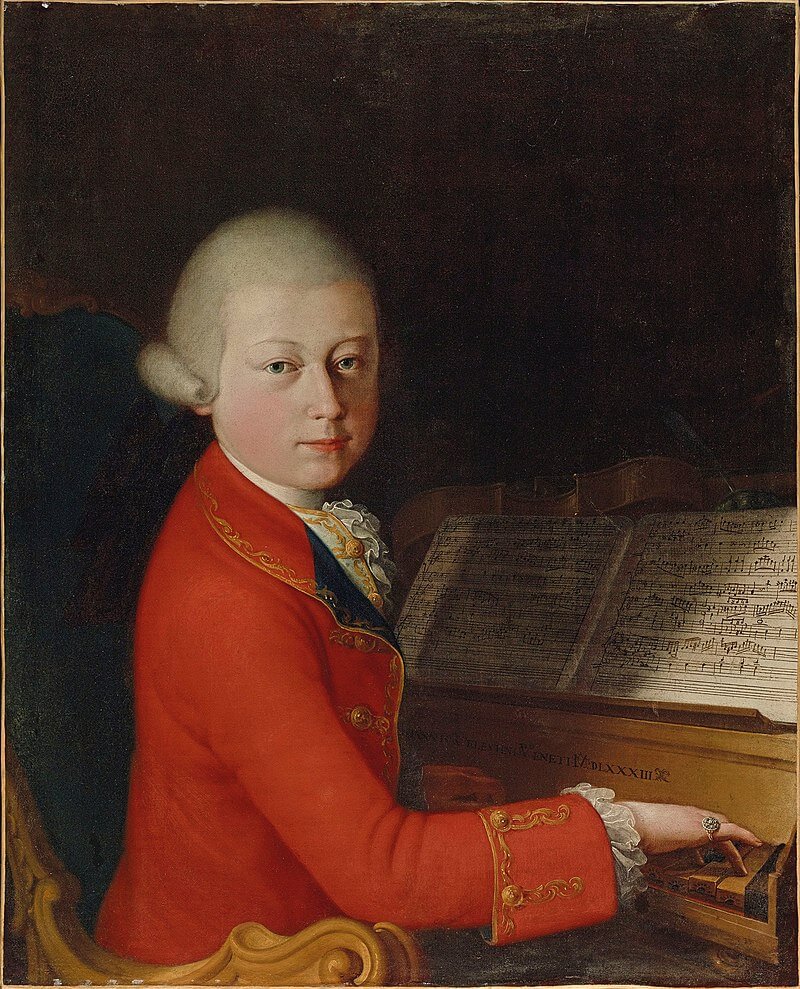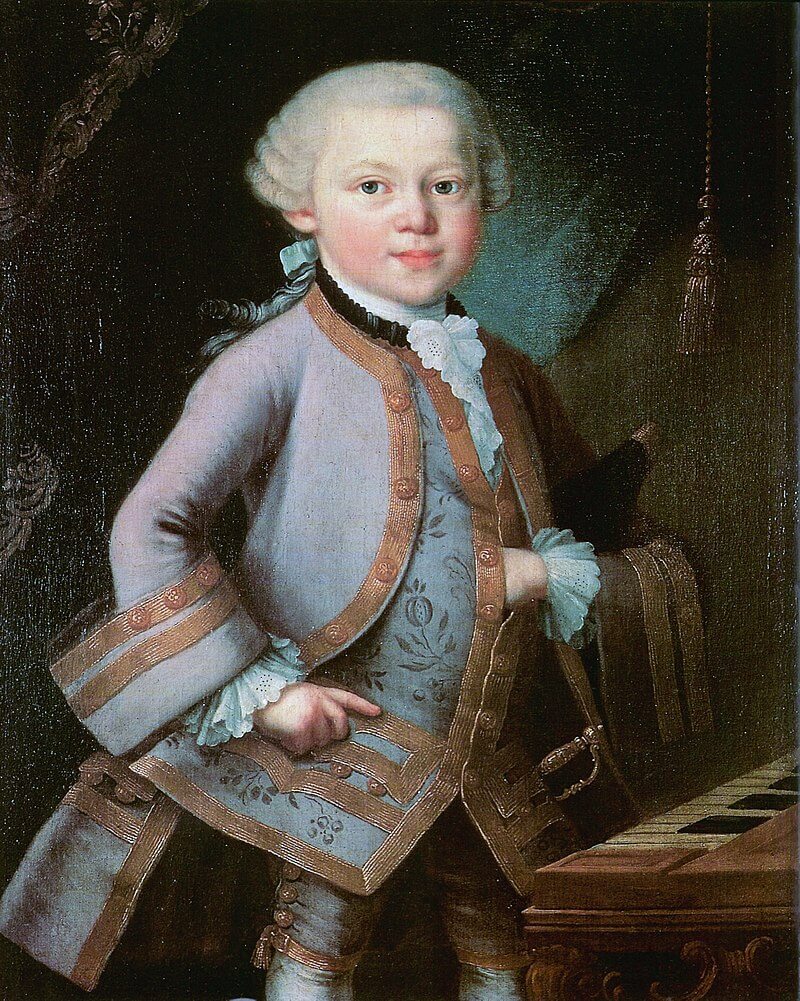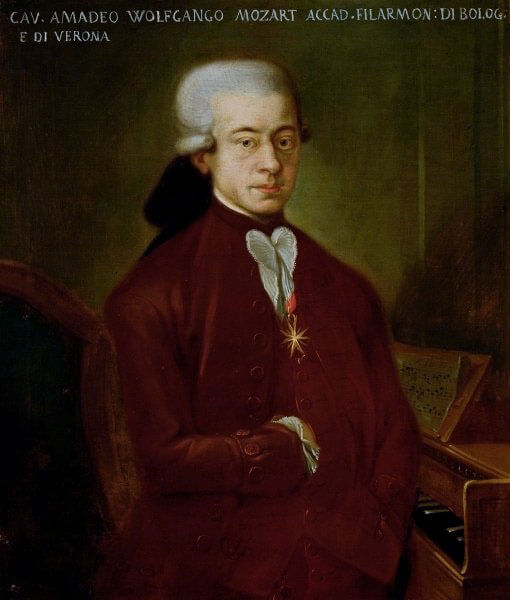Who was Wolfgang Amadeus Mozart? Information on Wolfgang Amadeus Mozart biography, life story, works and compositions.
Wolfgang Amadeus Mozart; Austrian composer: b. Salzburg, Austria, Jan. 27, 1756; d. Vienna, Dec. 5, 1791. One of the greatest geniuses in the history of music, he was the son of (Johann Georg) Leopold Mozart. A child prodigy, he began to play idly on a clavier when only three, and when five composed simple pieces which his father wrote down. His sister Maria Anna (“Nannerl”), five years his senior, also was talented as a musical performer, and in 1762 their father displayed them, first in Munich and then in Vienna, where they played for the Holy Roman emperor Francis 1 and Maria Theresa.
In 1763 some of the boy’s clavier pieces were printed, and Leopold embarked with his wonder children on a concert tour through the German states and to Brussels and Paris. On Jan. 1, 1764, the travelers were invited by Louis XV to attend supper at Versailles. In April, visiting London, the children played before George III, and Wolfgang began a close friendship with the youngest son of Johann Sebastian Bach, Johann Christian, whose gallant musical style influenced his own. By this time the eight-year-old boy was composing prolifically in many forms.

Source : wikipedi.org
Leaving England late in the summer of 1765, the Mozarts went to Holland, where both children fell seriously ill. After two Amsterdam concerts consisting largely of Wolfgang’s instrumental compositions, they went on to Belgium, Paris, Switzerland, and Munich, where they dined with the elector of Bavaria, returning to Salzburg in November. There the Prince-Archbishop Sigismund von Schrattenbach, doubting Wolfgang’s reputed talent for composition, tested it by keeping him at work under surveillance for one week. In May 1767 his Latin comedy Apollo et Hyacinthus, K.381, precursor of his great operas, was performed by students at the University of Salzburg.
During a visit to Vienna in the fall of 1767, Wolfgang and Nannerl were seriously ill with smallpox. In January 1768 they were received on friendly terms by Empress Maria Theresa. Her son, Joseph II, Holy Roman emperor, ordered an opera buff a from the boy; La finta semplice, K.51, was completed that spring, but not sung until May 1, 1769. Meanwhile, for the private theater of Leopold Mozart’s friend, Franz (or Friedrich) Anton Mesmer (the physician after whom mesmerism was named), Wolfgang had composed a German operetta, Bastien und Bastienne, K.50, probably first performed in September 1768.
From December 1769 to March 1771, Leopold and Wolfgang were in Italy, where the boy’s gifts won many honors. In July 1770, Wolfgang received the Order of the Golden Spur from Pope Clement XIV. At Milan, having passed a test of his operatic ability, Wolfgang was commissioned to compose an opera seria; the result was Mitridate, re di Ponto, K.87, first sung in Milan on Dec. 26, 1770, running for 20 nights.

Source : wikipedi.org
Remaining in Salzburg only from March 28 to Aug. 13, 1771, father and son returned to Italy. Wolfgang’s dramatic serenata Ascanio in Alba, K.lll, was performed at Milan, Oct. 17, 1771, during the ceremonies attending the marriage of Maria Theresa’s son Archduke Ferdinand. Shortly after the Mozarts’ return to Salzburg, Prince-Archbishop von Schrattenbach died; he was succeeded by the less easygoing Hieronymus von Colloredo, with whom both father and son were to have serious difficulties. Now 16, Wolfgang was pouring out symphonies, religious vocal pieces, divertimentos, chamber pieces, and other music in bewildering profusion. Late in 1772, visiting Italy for a third time, he heard his opera Lucio Silla, K.135, sung at Milan on December 26; his familiar motet Exsultate, jubilate, K.16S, with the popular “Alleluia,” was performed there in January 1773.
In July 1773, Leopold took Wolfgang to Vienna in the hope of a court appointment for him, but Maria Theresa, though receiving them graciously, made none. The Mozarts returned to Salzburg, remaining from October 1773 to December 1774, a period during which Wolfgang composed concertos for piano and for bassoon, masses, symphonies, serenades, and much else. Leopold and Wolfgang visited Munich late in 1774; Wolfgang’s La finta giardiniera, K.196, an opera buffa, was staged there on Jan. 13, 1775. Back in Salzburg, he had to compose hurriedly a dramatic festival play for a visit of Maria Theresa’s son Archduke Maximilian; this was II re pastore, K.208, first heard at SalzbOrg on April 23. During 1775, too, he composed all five of his violin concertos.

Source : wikipedi.org
During 1776, passed wholly in Salzburg, the Mozarts began to suffer the increasing ill will resulting from the prince-archbishop’s not entirely unjustified dislike of their spending so much time in travel. To that year and I7f7 belong many fine compositions, including the “Haffner” Serenade, K.250. Wearying of the lack of official preferment, Wolfgang again obtained leave in 1777, setting out on September 23, this time accompanied by his mother because Leopold was forced to remain in Salzburg. The goal was Paris, but after several stops en route, the travelers reached Mannheim on October 30. In that home of an orchestra famed for its virtuosity, Wolfgang, now 22, fell in love with Aloysia Weber, the soprano daughter of Fridolin Weber, an indigent musician; her first cousin, not born until 1786, was the distinguished composer Karl Maria Friedrich Ernst von Weber.
Wolfgang wanted to abandon the Paris trip, but Leopold wrote angrily from home, and the travelers proceeded to Paris, arriving on March 23, 1778. The French musical world was so happily involved in the famous “war” over the rival merits of Christoph Willibald von Gluck and Niccola Piccinni that Mozart’s presence created little stir. Offered a subordinate post as court organist at Versailles, he rejected it. For the great dancer Jean Georges Noverre he composed the ballet Les petits riens, K. App. 10, produced on June 11, 1778. Frau Mozart was taken seriously ill in June arid died on July 3, leaving Wolfgang alone in Paris, where he remained without success until September, when he returned to Mannheim. The court, and the Webers with it, had removed to Munich, and Leopold soon ordered Wolfgang to return to Salzburg, where their master seemed somewhat better disposed toward him. After stopping at Munich and again courting Aloysia Weber, although she had lost interest in him, Wolfgang reached Salzburg in January 1779. To that year belong many excellent works, including the familiar Sinfonia concertante for violin, viola, and orchestra, K.364.
Continuing to compose and to kick against the restraints of Salzburg life, Wolfgang was at home until November 1780, when he returned to Munich, this time to compose a commissioned opera seria— Idomeneo, K.366—for staging there. Its production on Jan. 29, 1781, opened a decisive year in his life. Commanded to join the prince-archbishop in Vienna in March, Wolfgang soon quarreled violently with him and resigned from his service. Finding the Weber family in Vienna, he boarded with them, this time falling in love with Aloysia’s sister Constanze, to whom he was secretly betrothed before his morally outraged father ordered him to live elsewhere. In July he began the first of his great operas, Die Entführung aus dem Serail, K.384.

Source : wikipedi.org
On July 16, 1782, Die Entführung aus dem Serail was sung in Vienna, and on August 4, disregarding his father’s vigorously expressed advice, Mozart married Constanze Weber. During that month the great Gluck requested a special singing of Die Entführung so that he might hear it, and invited the newly married couple to dinner. Although the success of Die Entführung in German cities and Prague spread Mozart’s fame, he now began to suffer the financial difficulties that dogged the remaining years of his life, often finding it necessary to support himself and Constanze meagerly on the proceeds of subscription ‘concerts. A son born to them on June 17, 1783, Raimund Leopold, lived only two months. Wishing to present Constanze to his father, Mozart took her to Salzburg (July-October 1783), then stopped at Linz, where the “Linz” Symphony, K.425, was composed.
Poverty, evidenced by borrowing from friends and fellow Freemasons, did not dry up his inspiration: these last, most difficult years were to witness his greatest achievements. His son Karl Thomas was born in September 1784. During a visit by Leopold Mozart to Vienna in 1785, (Franz) Joseph Haydn told the proud man that his son was the greatest composer known to him. In the fall of that year, Wolfgang began to compose Le nozze di Figaro, K.492, to a libretto by Lorenzo Da Ponte based on Pierre Augustin Caron de Beaumarchais’ play Le mariage de Figaro. This superb opera buffa was first sung at Vienna on May 1, 1786; although triumphantly successful, it was withdrawn after only nine performances.
Continuing to pour out masterworks, Mozart suffered the death of another short-lived son, Johann Thomas Leopold, in November 1786. In January 1787 he visited Prague, where the great’ D major “Prague” Symphony, K.504, was played. Having been commissioned to compose an opera for Prague, Mozart accepted Da Ponte’s suggestion of Don Juan as a subject. In May he was visited by the young Ludwig van Beethoven, in search of lessons. During that month, also, Leopold died at Salzburg, aged 67. Before the year was out, Wolfgang had completed Don Giovanni, K.527; had composed the familiar serenade Eine kleine Nachtmiisik, K.525; had witnessed the triumphant premiere of Don Giovanni at Prague on October 29; and had been appointed chamber musician and court composer by the emperor Joseph II. Also, Constanze had a daughter, Therese, who was to live only six months. Mozart’s last three great symphonies (E fiat, K.543; G minor, K.550; and C major “Jupiter,” K.551) were completed by August 1778, composed during a period when his trivial court post required him to turn out small dance pieces for official balls.
In 1789, visiting Leipzig, Mozart discussed the neglected music of Johann Sebastian Bach with Bach’s successor as cantor at the St. Thomas Church. In Berlin, in April, he was presented to Frederick William II of Prussia. Constanze was now almost constantly unwell, and Mozart was sinking more deeply into debt. Yet his magnificent Clarinet Quintet, K.581, belongs to this time, and in the fall of 1789 he began to compose, on order from Joseph II, a new opera buffa —Cosi fan tutte—to a Da Ponte libretto, which was sung in Vienna on Jan. 26, 1790. Another short-lived daughter, Anna, was born in November 1789. When Joseph II died in February 1790 and was succeeded by Leopold II, Mozart vainly hoped for greater official recognition. Attending Leopold’s coronation ceremonies at Frankfurt am Main, he played the solo piano part in what is known as the “Coronation” Concerto, K.537, which had been composed in 1788.
Mozart’s position in Vienna did not improve. But some time during 1790 the singer-actor-impresario Emanuel Schikaneder had suggested their collaborating on a German fairy opera Die Zauberfldte, K.620. Mozart worked on the score from late 1790. His son Franz Xaver Wolfgang was born on July 26, 1791, by which time he had almost completed the opera, often said to contain his most deeply moving music. During that month a stranger approached Mozart to order a Requiem Mass for an anonymous patron. Mozart also was commissioned to compose an opera seria —La clemenza di Tito, K.621—for the coronation of Leopold II as king of Bohemia. Deferring the Requiem, he went to Prague, where La clemenza was sung on September 6. Some days later he returned to Vienna in very bad health, but completed his masterly Clarinet Concerto, K.622, on September 28. He himself conducted the first performance of Die Zauberfldte two days later. Returning to the Requiem, K.626, he worked feverishly, soon experiencing fainting spells. Realizing that he could not complete the Requiem on time, he entrusted final details of it to his pupil Franz Xaver Siissmayr. On December 4, Mozart became partially paralyzed, and on the following day he died, aged 35. He was buried in an unmarked grave.
Twentieth century musical taste and judgment tend to classify Mozart with Bach and Beethoven as one of the greatest of composers, both for the variety and purity of his musical ideas and for his utter mastery in handling them. His finest achievements probably are his operas, concertos, and chamber pieces of many varieties. Mozart has few peers in the art of creating living dramatic personalities and none in his ability to combine serenely polished surfaces with rich emotional suggestiveness. And, through Haydn and Beethoven, his influence on the evolution of Western music is nearly unparalleled.
mavi